How Gamification in Apps Impacts Brain Performance
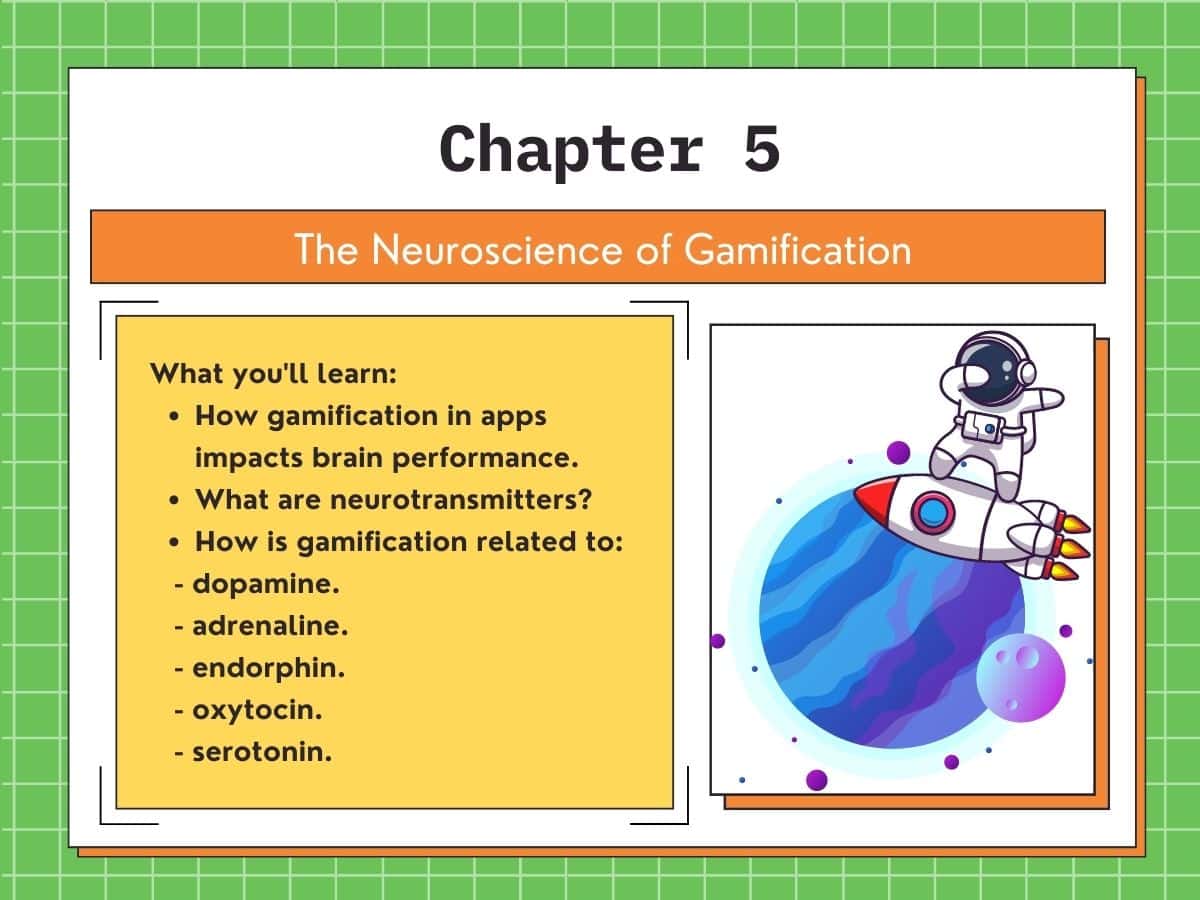
Competition, rewards, victory! Motivation gets the blood pumping. Today, we’ll be discussing the chemicals in the brain which lead to or prevent activity. Psychology explains why we’re motivated but neuroscience looks at the chemical processes involved and how gamification in apps actually creates action triggers. In this chapter, we’ll cover neurotransmitters and how this brain juice creates feelings that make action triggers or reduce them.

Chapters
You are in Chapter 5 of the Beginner’s Gamification Guide.
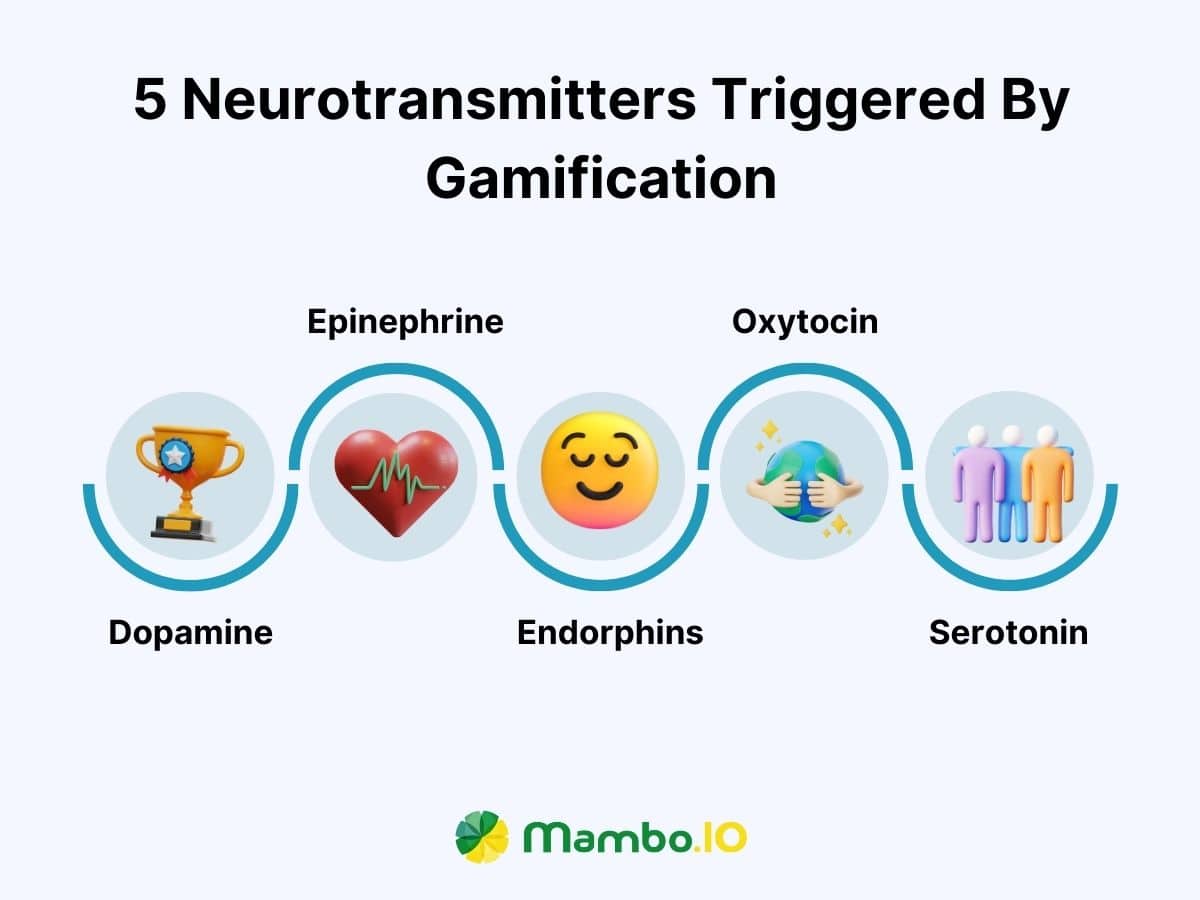
Why does adding gamification in apps work to create user engagement? The secret relies on the emotions and feelings triggered by chemical signals. This happens via rewards that spur engagement, team leaderboards that encourage progress together and badges that create a sense of pride. Every single mechanic within gamification is designed to help our bodies release these various neurotransmitters.
A neurotransmitter is a chemical conduit that connects the nerve cells and target cells within the body. This could be muscles, glands and the like. These chemicals send signals from one neuron to the other; telling them to do things. Our bodies are extremely complex; sending billions of these signals all of the time. It’s neurotransmitters that tell you to breathe, keep focusing or feel emotions. Every time anger, fear, happiness or sadness is felt; for example, these brain chemicals are working.
Functions of neurotransmitters:

We can classify the different brain chemicals into distinct categories to help make sense of what they do:
- Excitatory – An excitatory neurotransmitter creates a nerve impulse or ‘action potential’. Its goal is to send a little message or get cells to do something specific. This is the type of brain chemical that tells you a stove is on and making heat. It’s this neurotransmitter creating an excitatory response. One such neurotransmitter is glutamate.
- Inhibitory – This neurotransmitter does what it says on the tin: it inhibits action. It can even shut down other excitatory responses. Think of Gamma-Aminobutyric Acid (GABA) when you think of inhibitors.
- Modulatory – Here, brain chemicals are pulling a double shift. These responses adjust more than one nerve cell; sending several messages at once. They’re not as fast as the other neurotransmitters, however. But popular feel-good chemicals dopamine and serotonin are counted in this category.
The role of neurotransmitters in gamification
Neurotransmitters play a big role in supporting gamification in apps by driving action. So, we’ll look at the most common brain chemicals triggered by gamification:
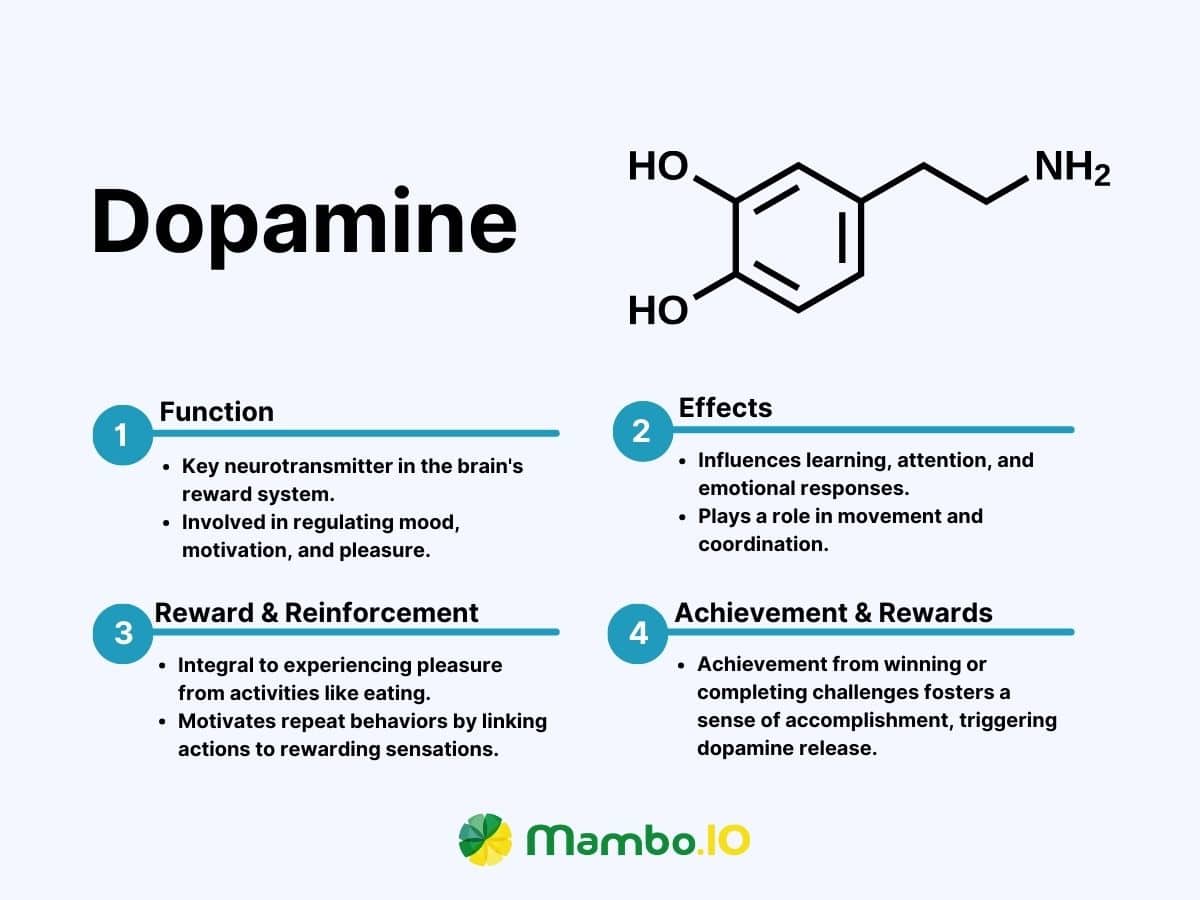
When you are walking in the street and smell your favourite perfume or when you eat a delicious meal or win a holiday to the Maldives… What do these 3 situations have in common? You probably released dopamine.
Dopamine is a brain chemical that lets us feel pleasure, motivation and satisfaction from our achievements. Every time we get a good outcome, dopamine reinforces those connections. That’s why, when your team earns a shiny badge for completing a learning module, they come back again to do another. It’s one of the most powerful levers for gamification in apps to pull.
However, just because we enjoyed something doesn’t mean it’s good for us. Dopamine release has a downside that can lead to crippling gambling addictions, alcoholism and sugar dependencies. That’s because our bodies release this potent chemical every time we get a good outcome – even if continued use is not advised.
Is dopamine addiction possible?
Well, no. One can only get addicted to the mechanisms which trigger dopamine. We can’t ingest or inject dopamine itself, but we can do activities which cause its release. This neurotransmitter is the reason why people do things that harm them in the long term. They’re chasing the fulfilling chemical release now.
How is dopamine related to gamification in apps?
Gamification in apps actually releases dopamine. You receive this brain chemical when you get a random or anticipated reward. It’s an important motivation trigger for gamification in apps. But where & how it’s released plus the functions of other brain regions all impact action. There are three types of motivation and dopamine relates to:
1. Incentives or extrinsic motivation
If you know you’ll be rewarded for a specific behaviour, you’re likely to do it. Like with gamification in apps, if you’re rewarded with redeemable points for completing all your weekly tasks, you will come to expect and look forward to that trigger. Not only is it satisfying to tick something off your list, but there’s a visible record of completion in the form of this badge. Now, you need to think it’s worth it, however. The different regions of your brain will assess if the effort = rewards. Once that assessment is made, the brain releases tonic dopamine to urge you to get started on the task.
2. Reward-based learning
If doing an activity suddenly results in an unexpected reward; like redeemable points, you will learn to attempt the task again on the off-chance of a surprise benefit. With reward-based learning, dopamine levels in the striatum, frontal cortex, and amygdala all increase, reinforcing this new knowledge. And the more times you get these random redeemable points, the stronger this association will be. However, it also works in reverse. If you complete your weekly tasks for a month straight without getting anything; you’ll quickly delete the association.
3. Intrinsic motivation
Sometimes we don’t need a reward. With gamification in apps, just tracking progress so one can see what they’ve achieved can provide a good level of motivation. It’s that satisfying feeling you get when you accomplish something you set your mind to. In this case, you’re not getting anything other than the activation of your insular cortex. This region seems to be more related to doing things for the gratification completion brings as opposed to the posterior cingulate cortex which gets involved with the cost-benefit analysis in the drivers above.
Gamification in apps works to trigger all of these motivators in one way or another. They can entice players to act and achieve the desired behaviours through random, intrinsic or expected rewards. Say you’re looking to increase sales team productivity or create more customer loyalty – you can drive these behaviours with gamification in apps.
Dopamine stimulates motivation, repetition and learning
When dopamine is released during gamification it stimulates the following:
- Motivation: Dopamine makes us want to reach new heights. We could have these goals as stated ones or unconscious targets, but, regardless, our reward system responds to gamification in apps to see us complete tasks.
- Repetition: We love routine. So when we learn that we’re getting satisfaction or rewards from doing a task, we’re going to repeat it. Gamification in apps leans on this to make sure we’re creating the right associations between in-app actions and dopamine release.
- Learning: Lastly, when we find new ways to get rewards or feel good about what we’re doing; we’re going to make mental notes. The more we repeat behaviours and get good outcomes through gamification in apps, the greater chance we’ll learn to make positive associations.
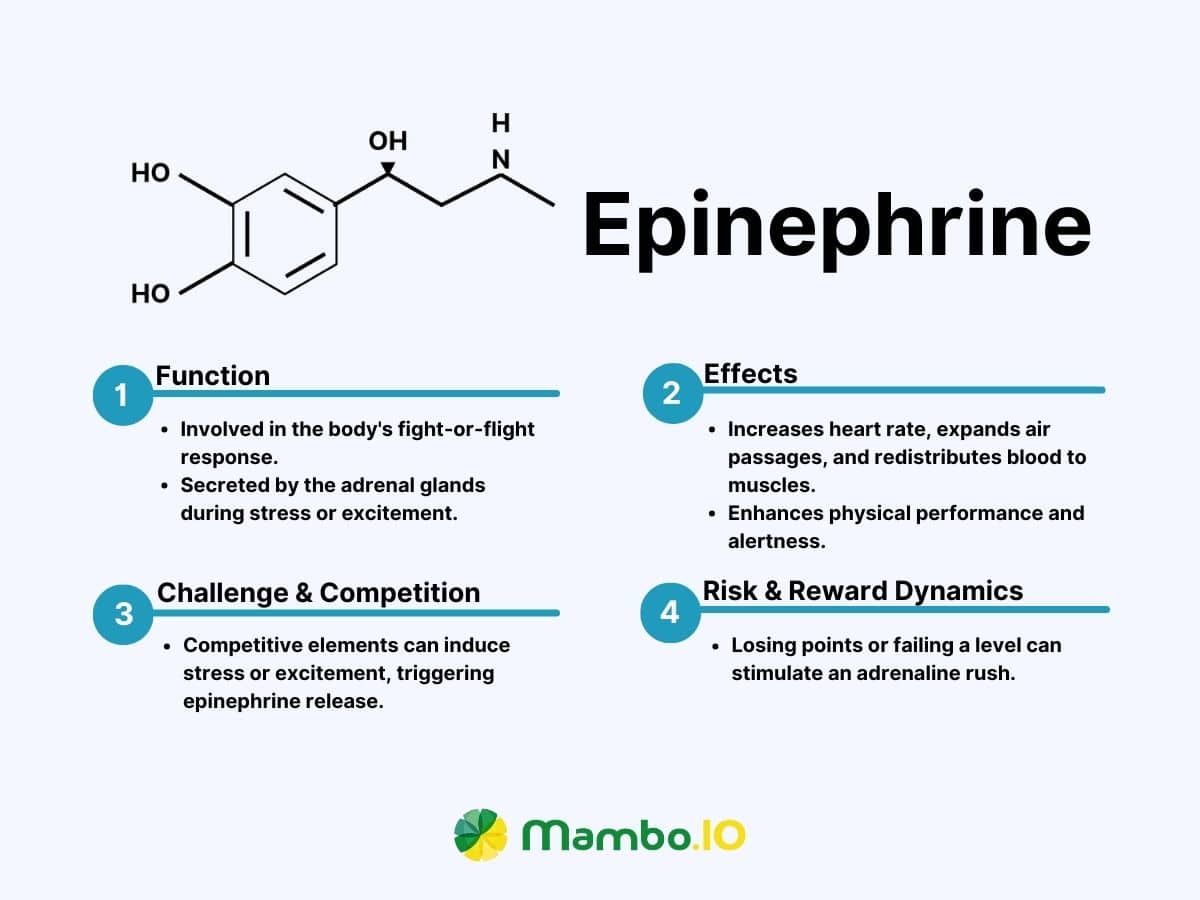
You know the rush you feel when you do something risky like cage diving with sharks, riding on roller coasters, skydiving or bungee jumping? That’s your adrenaline response; also known as epinephrine.
This fight or flight response is what happens when something exciting, scary, dangerous or threatening happens. This neurotransmitter is what helps us to react faster and get away or make a stand. Your heart will race. Your blood flow will increase and you’ll start burning sugar for fuel. It’s a powerful rush. And we can use it during gamification in apps as an attention-grabbing tool.
How is adrenaline related to gamification?
Gamification in apps is all about creating productive tension. The game mechanics might create a feeling of scarcity or a sense of loss. They might capitalise on mystery or build stress from close competition. Think about all the timers, countdowns and expiry dates you’ve experienced in your own life and you’re closer to understanding how epinephrine is used for gamification in apps.
Why would we want to do this? Well, an adrenaline response can help to create more focus and a sense of urgency. Users will be more alert and they might even take risks or make unconventional choices out of creative problem-solving. It’s no wonder why some people like this thrilling approach; it’s often more fun than a standard completion = reward format.
Users experiencing gamification in apps will find the game more exciting when it looks to trigger an adrenaline release. They might relish the opportunity to compete or enjoy finding creative solutions. Maybe they experience the near-win effect and find it extremely motivating. Regardless, triggering epinephrine release is an effective tool for successful gamification in apps.
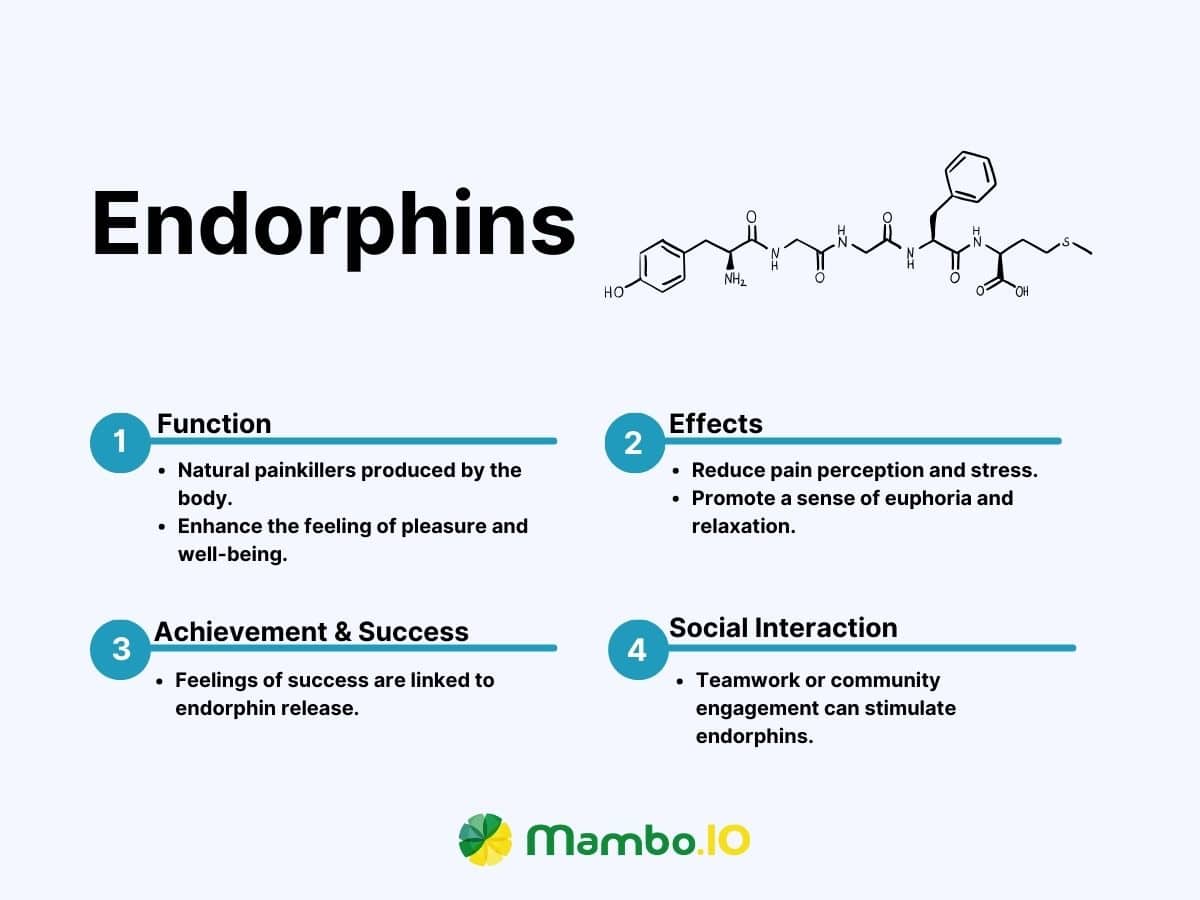
Have you ever been in a car accident, got bitten by a dog or broken your arm falling from a tree? If you remember the numb feeling that arrives long before the pain ever comes, that’s endorphins. It’s the body’s way of helping us survive stressful situations. And that’s not all it does. Endorphins help us feel less depressed, boost our self-esteem, moderate our appetite, curb anxiety, enhance our immune system and stave off pain.
These brain chemicals help us keep a more even keel. When you exercise, spend time with a loved one, get hurt or eat your favourite food; endorphins are released. These brain chemicals are largely beneficial and they can give users the oomph to keep going when triggered during gamification in apps.
The difference between endorphins and dopamine
Dopamine is your feel-good chemical. It’s all around rewards or perceived rewards. You feel its effects after the fact. Endorphins are a rush that helps you cope with stress, stave off pain and enjoy things at the moment. They’re not going to reinforce actions or motivate you. But they can help you make it to the end of a task when the going gets tough.
How are endorphins related to Gamification?
When users see the progress bar tick up as the countdown timer ticks down; this is when endorphins come in. This can push them to apply their skills and knowledge to complete the task. When they receive the reward, dopamine is released to give them the desired afterglow. But dopamine can come from just pushing a button and getting a reward. Endorphins require a challenge to get the payoff in neurotransmitters.
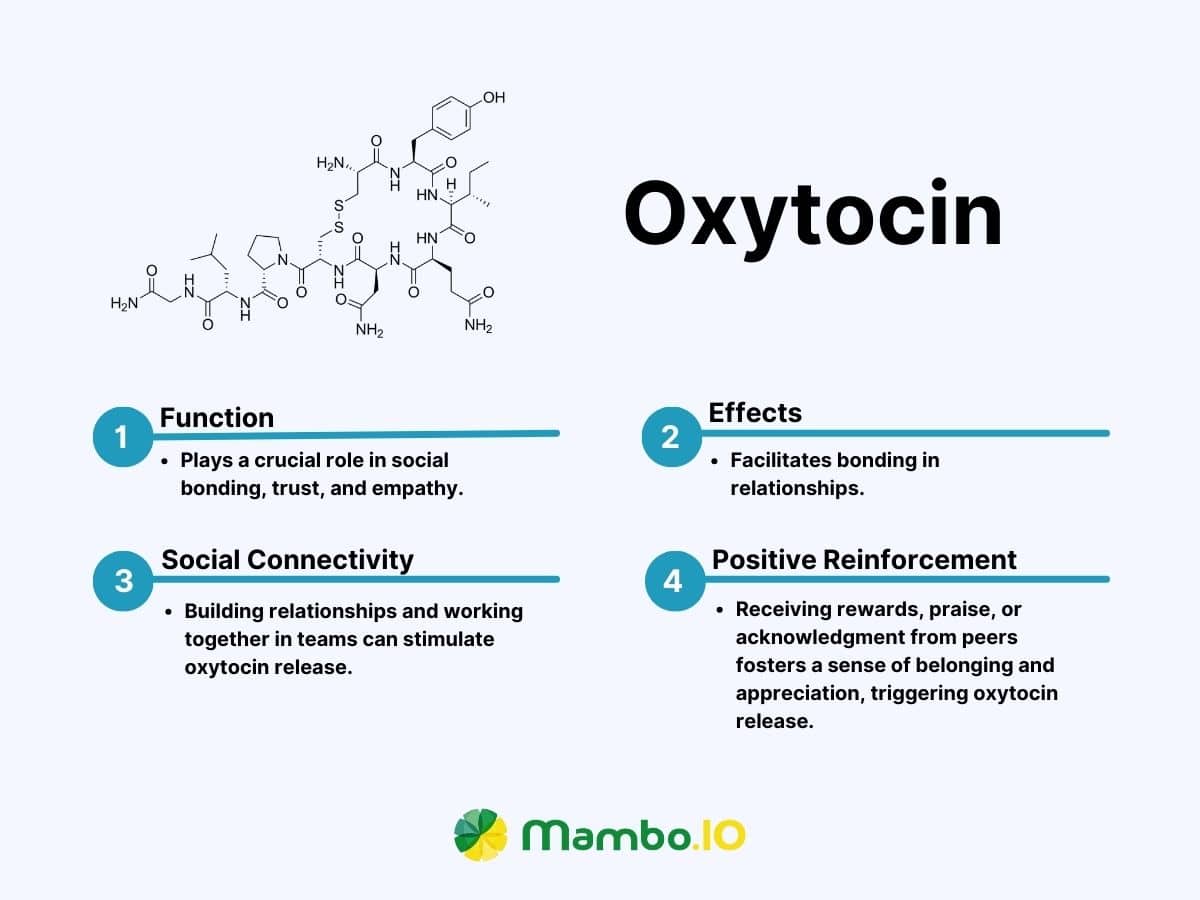
Remember the warmth you felt when you first hugged your grandmother or were recognised at school as the ‘most likely to succeed? What about when you needed help and someone was empathic to your plight? Oxytocin is deeply connected to bonding, empathy and social recognition. This powerful neurotransmitter can help us trust each other and work together as a team.
How is oxytocin related to Gamification?
Gamification in apps seeks to pull people out of silos and create communities. And this neurotransmitter is what helps users create pro-social behaviours. Oxytocin supports us to make healthy relationships. It also fosters collaboration, peer-to-peer recognition, sharing and empathy. In games, we can trigger oxytocin release when cooperative goals are set or if we’re mentoring or teaching others, for example.
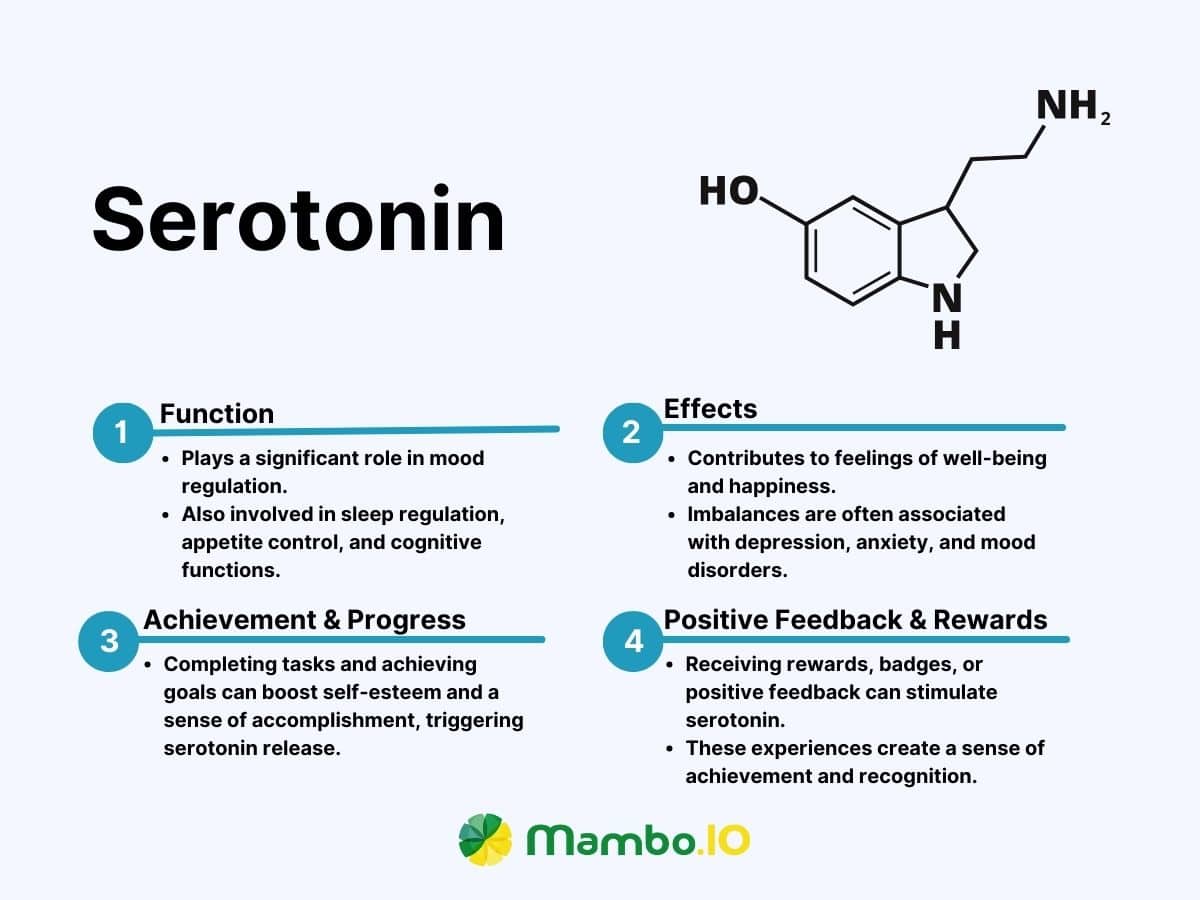
When you get a fuzzy feeling of contentment, calmness and well-being; this is the effect of serotonin. But it does more than just regulate your moods. Serotonin is understood to impact learning, memory, sleep, cognition, bone health and blood clotting too. Serotonin is also released through increased physical activity, so you’ll sometimes see gamification in apps tap into this phenomenon.
How is serotonin related to Gamification?
Serotonin is related to gamification in three ways:
- Chronic stress – This leads to low levels of serotonin, and stress needs to be managed. With gamification in apps, if the achievement bar is too high for a reward (for example) the user might begin to feel a stress response. But creating challenging yet achievable rewards can actually encourage completion, retention and rapidity.
- Exercise – Increased serotonin is related to regular exercise. So, if your use case is related to physical movement (like for fitness or health providers); you can incorporate exercise into your apps to trigger a serotonin release.
- Socialising – When gamification in apps encourages sharing and collaboration, this improves mood and triggers serotonin release.